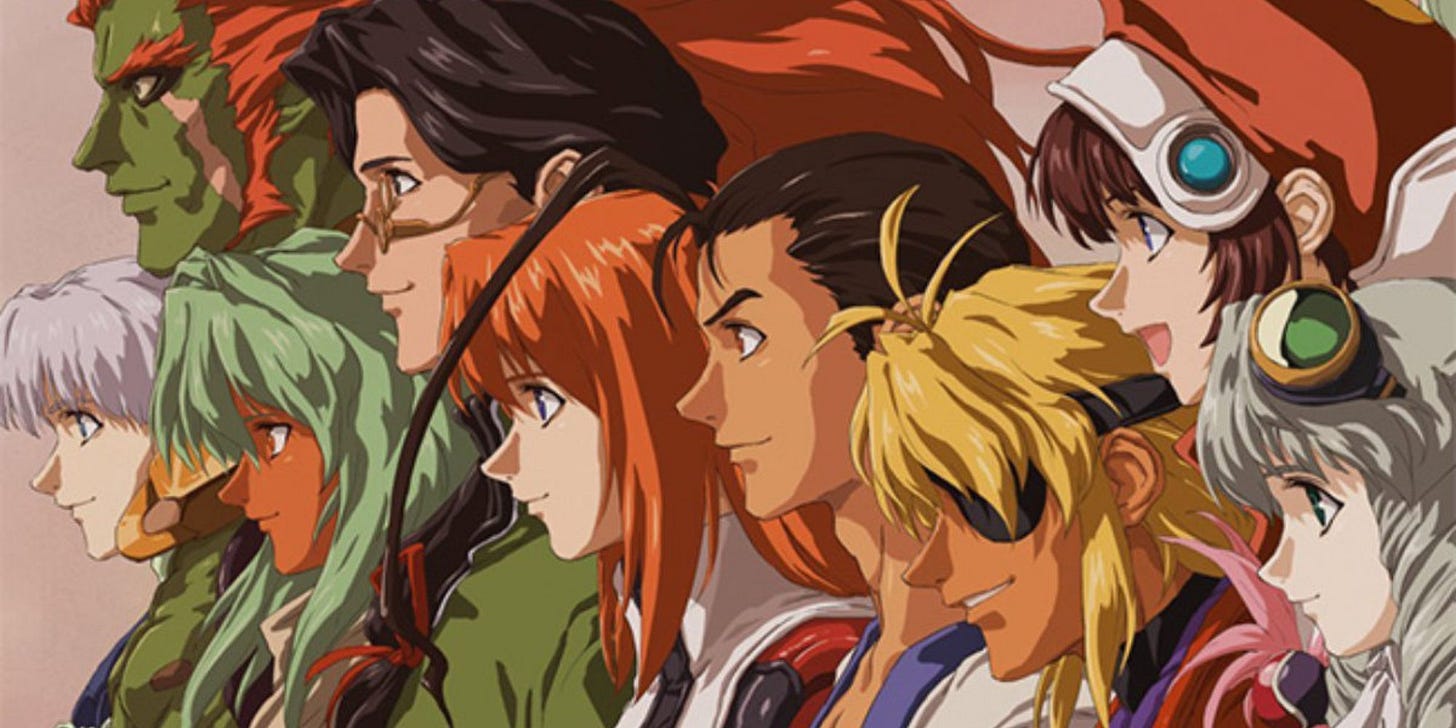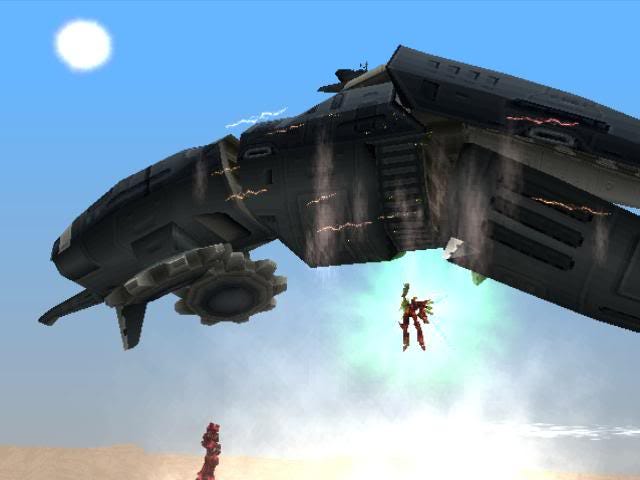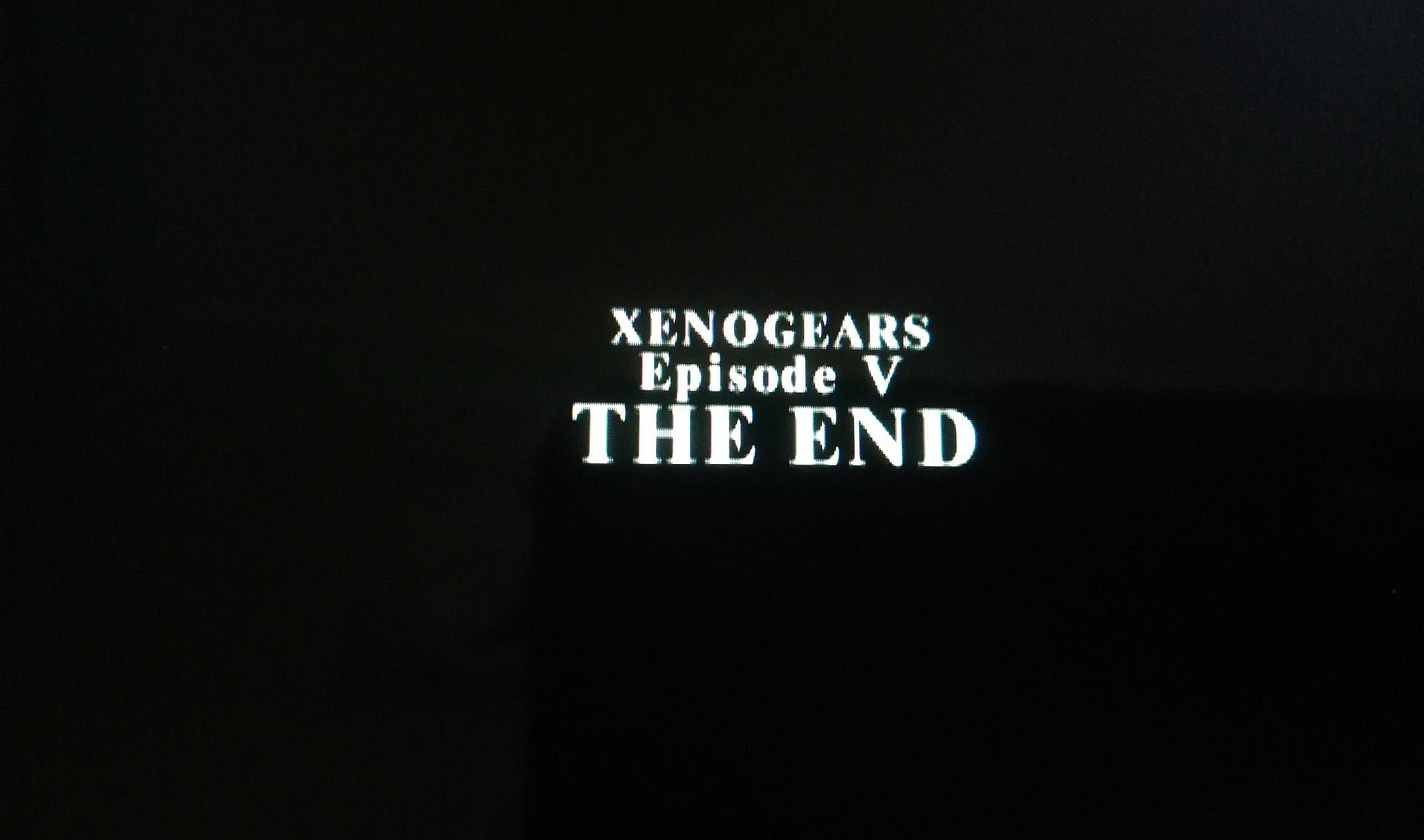Having already made one of these posts about why I love video games, I want to elaborate a bit more on one of my favorite games: Xenogears. This game is what’s called a JRPG, or Japanese Role Playing Game, that came out in 1998 for the original Playstation console. As a JRPG, Xenogears places a strong emphasis on character development and story, rather than on exploration as in open world RPGs, or on customization as tends to be the case in American RPGs. In their emphasis on story, JRPGs do tend to have a few fairly consistent tropes, one of which is that the final goal is to kill a god. Xenogears follows many of these tropes, but it does so in a way that still causes me to reflect on the story more than 25 years after I first played it.

I’ll say up front, Xenogears is far from a flawless game. In fact, as you reach the middle, it becomes fairly clear that the game was never finished. Segments of the story that should be playable become nothing more than some of the story characters sitting in a chair describing events. It starts to feel like a more normal game as you reach the very end, but the second arc makes for a bit of a jarring experience. Additionally, the entire game was localized (translated, with a lot of extra work to make sure everything makes sense) by a single person, Richard Honeywood. Overall, I think Honeywood did a fine job, but given that he had literally no help, there were clearly some things that slipped through the cracks.
Warts and all, a replay of Xenogears is always a good time for me. I still enjoy the story even after experiencing it six or seven times. A significant part of that enjoyment stems from the fact that this game actually introduced me to many concepts and ideas that I would eventually look into further: nanotechnology, molecular engineering, Freudian psychoanalysis, and the nature of God, to name a few. But I also enjoy fighting my way through the various battles of the game, until finally, yes, I’m in that final showdown with a god. Another part of what makes the journey so enjoyable is the music. Yasunori Mitsuda, who composed the soundtrack to the game, has produced some amazing scores, and though it is small, I think Xenogears is one of his best.
Additionally, the flaws in Xenogears ensured that it was never as widely played as some of the more popular RPGs of the 90’s. But, in a certain way, I also find that endearing. The fact that it’s less well known makes it more uniquely “mine.” Kind of like the dive bar with amazing Buffalo wings that almost nobody knows about.
The Basics
Xenogears was part of the first generation of RPGs that used three-dimensional graphics, as opposed to the standard two-dimensional maps that were common in earlier RPGs. This was quite a sea-change when it came to playing these kinds of games since it made the setting significantly more immersive.

Like many RPGs before and since, Xenogears employed a turn-based combat system meaning that characters and enemies took sequential actions during which they might attack, heal, use items, cast magic, defend, or escape. However, one of the things that made Xenogears unique was the fact that it had two related, but distinct combat systems: on-foot, and in “Gears.” Gears are giant (~15 m) combat mechs controlled by human pilots.

As such, the enemies could be small or large depending on how they were to be engaged. Additionally, there are some rather important differences in the combat mechanics. Battles fought to progress the story are always either on-foot or Gear combat, with no options to switch, however during random battles on the field, you might be on foot and encounter large monsters or enemy Gears, in which case your characters have the option to call their Gear or attempt to fight the large enemies without the assistance of your Gears, or you could do a mix: a single character in a Gear, and your other two on foot. It can make for a pretty interesting experience.
Another thing that can be very fun is the way in which some pieces of equipment can affect both on-foot and Gear combat. For example, an item called an “Ether Doubler” is an accessory that doubles the ether (Ether is the name for magic in this game) cost of spells but also doubles their power. It’s an accessory that characters equip on themselves and have access to during their on-foot battles. The cool thing is that it also works with several ether-based Gear weapons, so it’s a way to power up your Gears without using any equipment slots on the Gear itself. Looking through the game for these kinds of synergies can be a lot of fun. The two battle systems are additionally linked in the sense that having your characters learn more powerful deathblows (basically attack skills) will translate to having a wider array of more powerful attacks available while that character is piloting their Gear.
The on-foot combat is fairly similar to most RPGs with many options for healing, including magic and items. Gears, on the other hand, have very limited options for healing, options that are not always available and must be equipped on the gear in place of armor or other accessories. Additionally, Gears also have to deal with the fact that their attacks cost fuel, which must be managed if you are far away from a gear shop. Thus, the health and fuel of your gears are effectively finite resources that must be conserved as you progress through dungeons. It turns out that fuel isn’t such a big deal as there is a basic battle action that will regenerate fuel, but it does take a bit of learning about the game to figure out the best ways to get fuel back if you find yourself running low. While more of the dungeons tend to be Gear-based , many of them have both Gear and on-foot segments, and there are even a few dungeons that are purely done on foot. It never feels like one of the combat systems is secondary to the other, rather they both have to be attended to and developed in order to beat the more difficult battles.
While there’s quite a bit to learn in terms of specifics, the gameplay loop is basically straightforward: enter and complete dungeons as part of the story, fight bosses to progress major plot points, improve equipment and skills in order to tackle increasingly difficult dungeons and bosses.
The Music
Before I dig into the story a bit, I want to showcase some of the musical pieces from the game, because I think it’s my favorite video game soundtrack. Part of that is because the music does an excellent job of taking back to certain moments in the story, but more I think the musical pieces are very good compositions that do an excellent job of setting the mood.
One of the most common pieces of music is heard when your characters are on the world map moving from town to town. The title of the track is, “Adoration,” and I think my favorite part of it is the opening chords. Those first few notes always play when you transition to the world map, and they just sound like the start of a journey to me. You can hear the track with a bit of gameplay footage below.
A piece that has a somewhat similar sound is called, “Bond of Sea and Flame.” As can be seen in the video, this is the track that plays during the introduction sequence to the main story. Whenever I hear this track, it makes me think of intellectual discovery and puzzling out secrets. It’s a piece of music that I will listen to on repeat while I read.
This game also has some amazing battle music as well. The first of the next two pieces is called “Blazing Knights” or “Knight of Fire” and it plays during boss fights. Many JRPGs have great music to accompany major battles, and this is no exception. I particularly like the way the horns are used to increase the tempo only for things to slow down a bit, then have tension slowly build. The second piece is a bit more melodramatic. It’s called “Soaring” and starts with a sequence about a minute long that just builds and builds and builds toward a crescendo. After the crescendo hits, it’s basically montage music of flying towards battle. Like I said, melodramatic, but I love it.
A piece that’s a bit more subdued is called “Where Dreams Hatch.” It has a softer melody, but it always makes me think of loss or being forced to make a difficult decision. As you might guess, it’s prominently featured during major plot beats.
Another of my favorite pieces in the game is significantly more chilling. It’s the theme music of one of the game’s major antagonists. I remember hearing this music when that character appeared for the first time and having this feeling that was equal parts terror of the power this figure wielded and mystery about who or what this person was. Of course, in that first scene this character uses his Ether power to literally pick up a warship and throw it at another Gear. This music was perfect for that scene. It’s called, “Torn.”
A piece called “A Distant Promise” is probably the simplest in the game, but also one of the most poignant. It’s also a piece of “meta-music” in that it becomes clear at one point of the story that the characters themselves are listening to this music and discussing its meaning.
The last track I wanted to discuss is the only track in the game to have lyrics. Only a few tracks in JRPGs ever do this, but they generally do a very good job in writing lyrics in English and getting someone talented to sing them. This song is called, “Small Two of Pieces” sung by Joanne Hogg. This song is actually the music that plays only during the game’s ending, so I wasn’t nearly as familiar with it until I bought the Xenogears soundtrack. I absolutely love the way the sounds and lyrics of this song flow together.
One final thing that I think is very cool about the Xenogears soundtrack is the way in which many songs use elements of the same melody to produce different results. For instance, Torn and Small Two of Pieces you can hear the melodic structure used in A Distant Memory, but each of the three pieces of music employs it to a very different effect.
The reason that I could go on and on about the music of this game is because I have some fairly strong memories of the plot events of the game that occur while this music is playing. It makes both the music and the story more memorable for me. But at the end of the day, it’s the story that has made it worth replaying several times.
The Premise
Xenogears starts off with a very striking animated sequence of what appears to be a disaster aboard some kind of star ship. None of the characters are named, but the essence of it is that some sort of life form systematically takes over all of the ship's systems then eliminates the crew. It looks like the creature is stopped when the captain of the ship initiates the self-destruct and sends the wreckage of the ship crashing down onto an Earth-like planet. The video ends with a purple-haired woman emerging from a pile of debris while watching the rest of the ship rain down into the ocean. Oh, and there are several references to the Book of Genesis throughout the video. Check it out below.
As far as introductions to stories go, it was the perfect way to hook my thirteen year-old mind. Clearly there was a lot happening, and I didn’t have the context to understand any of it. But I wanted to—and I now had a whole game to dive into to figure out what the heck had just happened in that opening sequence.
However, it was quite a while before the game started to make any connections to that introduction movie. After a small infodump that establishes the game setting, we take control of Fei, our teenage, amnesiac, martial artist protagonist. After a short introduction area where we learn the basics of gameplay, we take control of Fei’s gear, fight off some enemies, then witness some very odd scenes that culminate in a tragedy for Fei’s tiny village. The next arc of the game is all about Fei’s relationships with different characters as he looks for a reason to use the power he has at his disposal—a power that many people want.
As the story progresses, we join up with pirates, try to help an exiled king reclaim his throne, get thrown in prison, escape from prison, help the church exterminate mutants, learn about the existence of hidden, but highly technologically advanced societies, and climb a big, big tower. We make some good friends and some bitter enemies. We see a bunch of things that we aren’t quite sure how to interpret, while picking hints here and there about the bigger picture for this world. All of this is pretty standard fare for JRPGs, that is, until we get to Disc 2.
Where It All Goes (SPOILERS AHEAD!!!)
While I don’t want to do a deep analysis of the plot here, I want to give an indication of some of the big reveals to show how I think the game plays out some of the standard JRPG elements in clever ways. In the event that I’ve convinced you to give this game a whirl, you’ll probably want to stop reading, as these are some of my favorite moments in the game when you start to learn this stuff. You’ve been warned!
So, that trope I talked about at the beginning of the article, the one where you kill God? Yeah, that’s what we end up aiming for in the second and third discs of Xenogears. Sort of. By “God” the people of this planet mean that being from the intro sequence that took over the ship and forced the captain to maroon it on this world.
We learn that this creature was an interplanetary invasion system built by a human civilization capable of interstellar travel. It had been decommissioned and was being transported to a planet where it could be isolated, but being an intelligent weapon, it was able to regain a measure of its consciousness and partially take over the transport vessel. Unfortunately for this weapon, called “Deus” in the game, the self-destruct damaged it so severely that many of its functions and components were compromised beyond its own ability to repair itself. However, it did have the ability to create artificial humans. That purple-haired woman from the opening movie was the first human Deus created and the one who would essentially serve as the vessel of its will on the planet, in addition to being responsible for creating other humans. Deus’s long term plan is for the human beings it created to evolve in such a way that they can recover and repair their “God,” Deus.
The second half of the game involves our cast of characters slowly uncovering this information and learning that they are living in the time of Deus’s resurrection. Through the evolution of Ether abilities in some humans and the development of nanotechnology and molecular engineering by other humans, Deus is finally ready to reawaken and return to the stars. Unfortunately, this means that the humans it created will be reincorporated into the “God” either as raw material or as semi-sentient weapons.
Of course, our main characters end up being among the few who have the power and fortitude to challenge this fate, which sets the stage for the final showdown where we fight God! There’s quite a bit more to the story, in particular the characters’ psychology and relationships, the historical events of the planet, and what makes Fei in particular the potential “fly in the ointment” for Deus’s plans.
Even though this portion of the story is significantly less interactive, with much of it being told through walls of scrolling text and other types of infodumps, I still find myself on the edge of my seat looking for things I’ve missed or forgotten from previous playthroughs.
When the final credits roll, we’re treated to something of a surprise: we’re told that this was Xenogears Episode V. What the hell!? There’s more to this story?
Well…sort of. There are no other Xenogears games, but it did spawn some spiritual successors that were developed by many of the same people who worked on the original Xenogears. The first was the Xenosaga trilogy. It initially seemed like those three games might be the prequels to Xenogears, but the actual connection between the two series is never really made. This is probably because the creators of Xenosaga were unable to obtain rights to the original Xenogears IP. The second set of successor games are the Xenoblade Chronicles, which I know relatively little about, as I’ve never really had the chance to play them. Nevertheless, part of me continually hopes that other episodes of Xenogears will appear one day. Probably not…but who knows?






